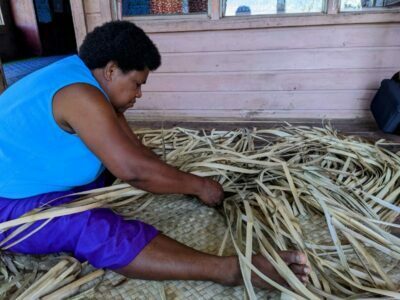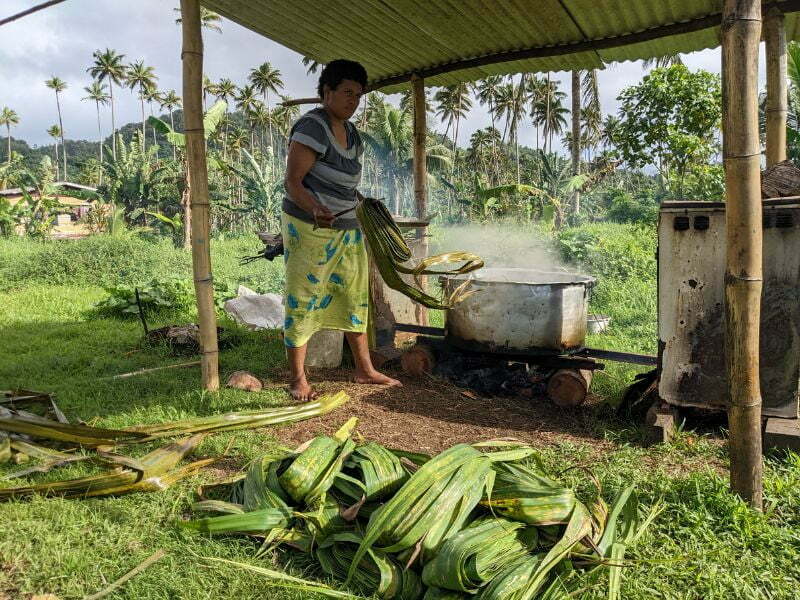Every week, women in villages like Valeni and Naiqaqi come together to weave their traditional mats. An important part of their traditional knowledge and culture, these are used for homes and for special occasions, making them an invaluable commodity to sell at local markets as an important income source.
It’s a lot of work: they need to first collect voivoi – leaves of the pandanus plant – then boil them to make them more malleable, dry them in the sun, then roll and cut them before they even begin to weave. Weaving and selling these mats requires considerable knowledge of the local area and resources, shared skills, effort and teamwork – all things that are essential to building climate resilience itself. So it’s appropriate that the women of Valeni chose these mats to be their symbol of resilience.
“We earn money from this, the ladies here,” says Talei Vakaloloma, a member of the women’s group in Valeni. “We sell them, so we don’t have to go and ask for money from anyone.
“In our women’s club here we are planing to weave more mats to cover up our hall. We also weave for funerals and for weddings, and for our own houses, rather than go to the market to buy the rugs.”
Women in Valeni, Naiqaqi and elsewhere do not only weave mats. They also do the majority of the vegetable farming in both villages, while doing much of the gathering and catching of seafood. Women play a major role in selling village goods at the market in Savusavu, the nearest major market to Valeni and Naiqaqi, providing a significant source of income, as well as operating small business ventures like the local canteens.
The work of weaving mats and selling goods is part of the tradition of solesolevaki, the practice of cooperation that ensures everyone gets the help they need and strengthens ties throughout the community. Women make an enormous contribution to community resilience by maintaining this tradition.
Understanding the role of women in resilience is a key part of Climate Resilient Islands. Climate change impacts can often exacerbate existing gender inequalities, making it essential that mitigation and adaptation initiatives like those of the CRI programme must integrate the strengths and needs of women to ensure climate challenges are met with nuanced and informed responses.
To best understand the unique roles and perspectives of women, the CRI programme splits several activities into women’s groups and men’s groups. This helps to learn how women see different natural and physical resources that contribute to local livelihoods and wellbeing.
Rosi Drodroloagi, a member of the Naiqaqi Women’s Group, believes understanding the perspective of women to be very important, saying women have a crucial part to play in building strength and resilience in her community.
“In my village, women are the the most active group,” she says. “They have the interest in doing something to overcome some of the challenges in the village. To overcome poverty in this village, women are the most successful income generators.”

A woman weaving a traditional pandanus leaf mat
One such source of income generation in Naiqaqi is the micro-enterprise established by the women’s group, which sells local handicrafts, including the woven mats, as well as homemade jams and other items.
“We do work in order to bring income in the family. We do community work, group work – for example, we do weaving. These are some of the ways that we work to overcome poverty, that bring income to our families,” Rosi says.
“In this community, women are very much important.”
As villages like Valeni and Naiqaqi continue to adapt to the impacts of climate change, the importance of the women’s work will likely only increase, as they continue to grow and gather food, find income sources and pass on the knowledge of mat weaving – which not only brings income, but is also an important aspect of their culture and their resilience.
“In our women’s club, those who don’t know how to weave usually come into the hall and the old women teach us,” Ms Vakaloloma said.
“I don’t know about the next generation. But we hope to keep it alive. Otherwise, in the years ahead, we will not find this kind of mat inside our homes.”

